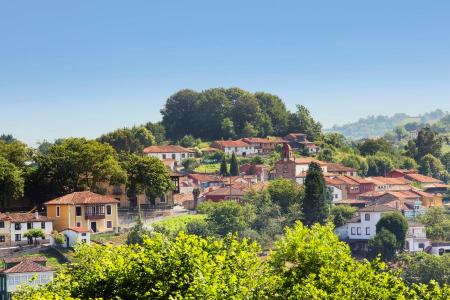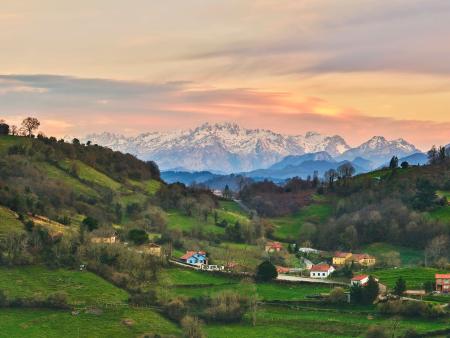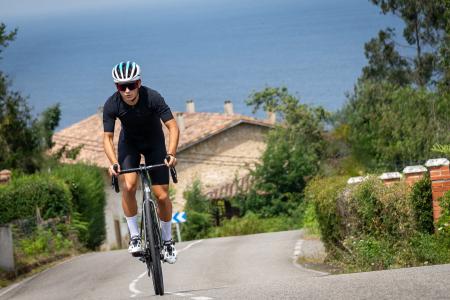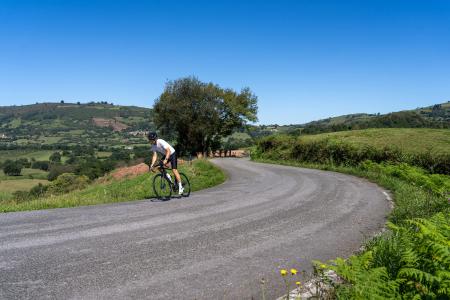Comarca de la Sidra
- Dirección Bimenes, Cabranes, Colunga, Nava, Sariego, Villaviciosa Oriente de Asturias

Located less than an hour's drive from Oviedo/Uviéu and half an hour from Gijón/Xixón, to experience cycle tourism in the Comarca de la Sidra is to awaken the senses with the aroma of the orchards, the taste of freshly poured cider and the beauty of its stunning rural surroundings.
Rolling along the coastline
Among the most outstanding routes for cycle tourists are those that run along the coast, linking Villaviciosa with Ribadesella/Ribeseya, to the right, and with Gijón/Xixón, to the left. Of considerable difficulty, pedalling while enjoying the views of the Bay of Biscay makes the challenging slopes of these routes more bearable.
The coastal route in this section runs along asphalted roads that lead to towns of great beauty such as Villaviciosa, where it is worth stopping and taking some time to stroll around its historic centre and visit the church of Santa María de la Oliva, in Romanesque style and declared an Asset of Cultural Interest.
In Seloriu, heritage enthusiasts can admire the church of Santa Eulalia, declared a Historic-Artistic Monument, and in Valdediós, its Monumental Site, made up of the church of San Salvador de Valdediós, a landmark of pre-Romanesque or Asturian Art, and the Cistercian monastery of Santa María la Real de Valdediós.

Among the natural treasures of the Comarca de la Sidra are the Rodiles beach and the Villaviciosa estuary, a Partial Nature Reserve of great ecological value, renowned for its impressive landscape and its importance for birdwatching.
Discovering the interior of the Comarca de la Sidra by bike
Mountain bikers will find a demanding route in the Comarca de la Sidra with the ascent to Les Praeres, with an average gradient of 12.9%, as the main challenge. The summit invites a stop to admire the views of the Sierra de Peñamayor before starting the descent along a gravel track.
The great coastal route can be linked to the inland route by cycling through this region along several routes that run along local roads without much traffic. On the route from Villaviciosa to Nava, it is worth stopping to visit the churches of San Juan de Camoca and San Juan de Amandi.
When you reach Nava you should set aside time to explore its Cider Museum and learn more about one of the most representative traditions of Asturias.

Another cycle tourism route in the Comarca de la Sidra starts in Colunga, with its palatial houses and modernist mansions. Its Jurassic Museum of Asturias (MUJA) or the extensive beach of La Griega, where dinosaur footprints can be seen along the coastline, will delight lovers of history and palaeontology.
This route heads towards Arriondas/Les Arriondes, bordering the Sierra del Sueve. The Sierra del Sueve Interpretation Centre in Gobiendes, where you can also hire bicycles, is well worth a stop along the route. In the same town is the church of Santiago, a fine example of Asturian pre-Romanesque architecture.
The interior of the region offers several itineraries for cycling through apple orchards, green pastures and small charming villages such as Ceceda/Cecea, on the mountain route that leads from Oviedo/Uviéu to Cangues d'Onís/Cangas de Onís.
Routes for cycle touring enthusiasts on gravel bikes
Gravel cyclists will enjoy options such as the Vuelta a Sariego or the Vuelta a Cabranes, both of moderate difficulty and with a mixed route between road and dirt tracks, perfect for cyclists looking for adventures off the asphalt. A more accessible route for gravel cyclists enters Bimenes from Llangréu/Langreo. Along the way, cyclists will find small towns and villages surrounded by green meadows.
In the Comarca de la Sidra cycle touring experience, the rural tradition can be felt in every corner. Its landscapes, with impressive forests, mountains and rivers, offer the cyclist a unique spectacle, especially in spring, when the apple trees blossom.
A stop at one of the small cider houses and restaurants where you can sample some of the typical dishes of Asturian gastronomy, accompanied by a bottle of cider, will be the ideal way to complete a trip to this region where the apple is a fundamental part of its life, festivals and traditions.
Cycle touring routes in the Comarca de la Sidra
 29
km
Cabranes is a council with a gently hilly terrain, located in the central-eastern area and included in the region of La Sidra. It stands out for...
Tour of Cabranes
29 km
Place of Start - End
Santolaya - Santolaya
Routes
One-day routes
IBP index
IBP index: 54
Type of route
Type of route: Circular
Modality
Road
29
km
Cabranes is a council with a gently hilly terrain, located in the central-eastern area and included in the region of La Sidra. It stands out for...
Tour of Cabranes
29 km
Place of Start - End
Santolaya - Santolaya
Routes
One-day routes
IBP index
IBP index: 54
Type of route
Type of route: Circular
Modality
Road
 22
km
Gravel route through one of the smallest and most beautiful councils in the central area, covering most of the valley and its northern limit in a...
Tour of Sariego
22 km
Place of Start - End
Vega - Vega
Routes
One-day routes
IBP index
IBP index: 54
Type of route
Type of route: Circular
Modality
Gravel
22
km
Gravel route through one of the smallest and most beautiful councils in the central area, covering most of the valley and its northern limit in a...
Tour of Sariego
22 km
Place of Start - End
Vega - Vega
Routes
One-day routes
IBP index
IBP index: 54
Type of route
Type of route: Circular
Modality
Gravel
 46
km
Itinerary that combines some of the councils of the Nalón mining basin, such as Langreo and San Martín del Rey Aurelio, with a marked industrial...
Langreo-San Martín-Bimenes
46 km
Place of Start - End
Llangréu/Langreo - Llangréu/Langreo
Routes
One-day routes
IBP index
IBP index: 48
Type of route
Type of route: Circular
Modality
Road
46
km
Itinerary that combines some of the councils of the Nalón mining basin, such as Langreo and San Martín del Rey Aurelio, with a marked industrial...
Langreo-San Martín-Bimenes
46 km
Place of Start - End
Llangréu/Langreo - Llangréu/Langreo
Routes
One-day routes
IBP index
IBP index: 48
Type of route
Type of route: Circular
Modality
Road
 60
km
This route is divided into two distinct sections, starting in Nava, the capital of Comarca de la Sidra, and finishing in Cangues d'Onís/Cangas de...
Comarca de la Sidra
60 km
Place of Start - End
Nava - Cangues d'Onís/Cangas de Onís
Routes
One-day routes
IBP index
IBP index: 166
Type of route
Type of route: Linear
Modality
MTB
60
km
This route is divided into two distinct sections, starting in Nava, the capital of Comarca de la Sidra, and finishing in Cangues d'Onís/Cangas de...
Comarca de la Sidra
60 km
Place of Start - End
Nava - Cangues d'Onís/Cangas de Onís
Routes
One-day routes
IBP index
IBP index: 166
Type of route
Type of route: Linear
Modality
MTB
 63
km
This route allows you to enjoy both the coastal landscape with well-preserved beaches, as well as beautiful rural environments with several points...
Villaviciosa-Gijón
63 km
Place of Start - End
Villaviciosa - Gijón/Xixón
Routes
Great route
IBP index
IBP index: 91
Type of route
Type of route: Linear
Modality
Road
63
km
This route allows you to enjoy both the coastal landscape with well-preserved beaches, as well as beautiful rural environments with several points...
Villaviciosa-Gijón
63 km
Place of Start - End
Villaviciosa - Gijón/Xixón
Routes
Great route
IBP index
IBP index: 91
Type of route
Type of route: Linear
Modality
Road
 67
km
This coastal route allows you to enjoy the coastal scenery as well as beautiful rural landscapes and several points of cultural interest. It runs...
Villaviciosa - Gijón
67 km
Place of Start - End
Villaviciosa - Gijón/Xixón
Routes
Great route
IBP index
IBP index: 123
Type of route
Type of route: Linear
Modality
Gravel
67
km
This coastal route allows you to enjoy the coastal scenery as well as beautiful rural landscapes and several points of cultural interest. It runs...
Villaviciosa - Gijón
67 km
Place of Start - End
Villaviciosa - Gijón/Xixón
Routes
Great route
IBP index
IBP index: 123
Type of route
Type of route: Linear
Modality
Gravel
 57
km
This route allows you to enjoy the coastline as well as the views of Picos de Europa. It runs through coastal landscapes of high ecological and...
Ribadesella-Villaviciosa
57 km
Place of Start - End
Ribadesella/Ribeseya - Villaviciosa
Routes
Great route
IBP index
IBP index: 79
Type of route
Type of route: Linear
Modality
Gravel
57
km
This route allows you to enjoy the coastline as well as the views of Picos de Europa. It runs through coastal landscapes of high ecological and...
Ribadesella-Villaviciosa
57 km
Place of Start - End
Ribadesella/Ribeseya - Villaviciosa
Routes
Great route
IBP index
IBP index: 79
Type of route
Type of route: Linear
Modality
Gravel
 60
km
This route allows you to enjoy both the coastline and the views of Picos de Europa. It runs through coastal landscapes of high ecological and...
Ribadesella - Villaviciosa
60 km
Place of Start - End
Ribadesella/Ribeseya - Villaviciosa
Routes
Great route
IBP index
IBP index: 75
Type of route
Type of route: Linear
Modality
Road
60
km
This route allows you to enjoy both the coastline and the views of Picos de Europa. It runs through coastal landscapes of high ecological and...
Ribadesella - Villaviciosa
60 km
Place of Start - End
Ribadesella/Ribeseya - Villaviciosa
Routes
Great route
IBP index
IBP index: 75
Type of route
Type of route: Linear
Modality
Road
 79
km
This route is notable for the lush mountain scenery it passes through, with stunning views of the Sierra del Sueve and Picos de Europa in the...
Oviedo-Cangas de Onís
79 km
Place of Start - End
Oviedo/Uviéu - Cangues d'Onís/Cangas de Onís
Routes
Great route
IBP index
IBP index: 78
Type of route
Type of route: Linear
Modality
Road
79
km
This route is notable for the lush mountain scenery it passes through, with stunning views of the Sierra del Sueve and Picos de Europa in the...
Oviedo-Cangas de Onís
79 km
Place of Start - End
Oviedo/Uviéu - Cangues d'Onís/Cangas de Onís
Routes
Great route
IBP index
IBP index: 78
Type of route
Type of route: Linear
Modality
Road
 23
km
This route links the main coastal and inland routes between the towns of Colunga and Arriondas/Les Arriondes. It is a short route that uses local...
Colunga - Arriondas
23 km
Place of Start - End
Colunga - Arriondas/Les Arriondes
Routes
One-day routes
IBP index
IBP index: 79
Type of route
Type of route: Linear
Modality
Road
23
km
This route links the main coastal and inland routes between the towns of Colunga and Arriondas/Les Arriondes. It is a short route that uses local...
Colunga - Arriondas
23 km
Place of Start - End
Colunga - Arriondas/Les Arriondes
Routes
One-day routes
IBP index
IBP index: 79
Type of route
Type of route: Linear
Modality
Road
 33
km
This route serves as a link to connect the great touring between the towns of Villaviciosa and Nava. Both municipalities belong to the Cider...
Villaviciosa - Nava
33 km
Place of Start - End
Villaviciosa - Nava
Routes
One-day routes
IBP index
IBP index: 83
Type of route
Type of route: Linear
Modality
Road
33
km
This route serves as a link to connect the great touring between the towns of Villaviciosa and Nava. Both municipalities belong to the Cider...
Villaviciosa - Nava
33 km
Place of Start - End
Villaviciosa - Nava
Routes
One-day routes
IBP index
IBP index: 83
Type of route
Type of route: Linear
Modality
Road








